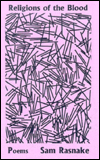Landscape with a Solitary Traveler

Yosa Buson was a master poet as well as an artist. "Washing the hoe—" is one of the most important pieces of writing in my world.
Buson’s is a poetry of essentials. His imagery – lean, sharp, objective – is built with a quick stroke. No waste. Exact. Forceful.
*
Washing the hoe—*
ripples on the water;
far off, wild ducks.
~
Butterfly
sleeping
on the temple bell.
~
A heavy cart rumbles by
and the peonies
quiver.
~
Autumn evening—
there's joy also
in loneliness.
~
Blow of an ax,
pine scent,
the winter woods.
~
Early spring:
In the white plum blossoms
night to next day
just turning.
["Early spring:" was Buson's deathbed poem – Winter, 1783.]
(trans. Robert Hass)
I consider Buson to be Bashō's literary opposite – yet both are indispensable. While each poet is concerned with precision – certainly – Bashō’s writing is of the moment and Buson’s is in the moment.









2 comments:
I can't tell you how many times I've come back to visit this post.
Yes, joy.
Especially when it is aloneness, rather than loneliness.
A big difference between the two, I think. As different as suffering versus pain.
Thanks for this post. It feels like a gift or a friend or the lone house on a dark street with a light on.
found the blog via laurel's and am glad to have read this post. a rare find for me, i hadn't read buson before and loved the butterfly on the temple bell. thanks.
ani
Post a Comment